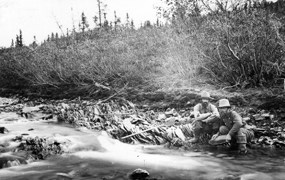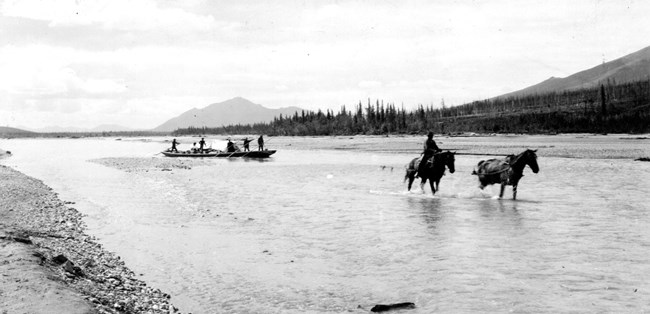
Courtesy of USGS Photographic Library (Schrader 402). This article by H. Pringel was published in The Pathfinder (Valdez) in that magazine’s April 1921 issue. It describes two decades of placer gold mining in the Koyukuk River drainage. Most of the boomtowns established in the heady days of 1898 and 1899 have disappeared, but Wiseman, Coldfoot, and the ghost town of Old Bettles still exist as reminders of the region’s gold mining past. The history of mining on the Koyukuk River apparently dates back no further than the year 1898. In this year about seventy small steamers made their way up the river to the sites of the present towns of Bergman, Bettles and other points along the river. These were loaded with prospectors, who in most instances, owned their boats. Most of these prospectors were from the eastern States with a scattering of old timers, and to these latter is undoubtedly due the fact that the fleet succeeded in reaching six hundred miles or more up the river. Many of the Eastern men, unused to the hardships incident to a trip of this character, through a practically unknown region, and discouraged by the desolate appearance of the country, at once abandoned the enterprise and returned to the States before winter should overtake them. Many of them abandoned their boats, taking passage down the stream with others, while many left their boats in charge of friends who, more courageous, remained behind to try their luck in the unknown country into which they had penetrated. As a result, here and there along the river banks may be seen the bleaching bones of little steamers which once formed a part of the gallant fleet which bore the first stampeders to the Koyukuk. 
Courtesy of USGS Photographic Library (Maddren, A.G. 19). Enough of these stampeders remained to demonstrate that the gravels of the Koyukuk and its tributary stream were not barren of the golden lure which had tempted them to undertake their arduous voyage. The prospectors, far from home and friends, but with fond memories of mothers, sisters, sweethearts, let their fancies swell upon the names of the gentler sex when it came to the naming of the various streams as is evidenced by Myrtle Creek, Clara Creek, Rosie Creek, etc. Myrtle and Emma Creeks, the former a tributary of Slate Creek, which is a tributary of the Middle Fork of the Koyukuk, and on which the town of Coldfoot is now located, and Emma Creek, also a tributary of the Middle Fork, were among the very first to be prospected, and are said to have produced more than one hundred thousand dollars during the first few years they were worked, and have been producing some gold ever since. Gold Creek and Gold Bench were also among the creeks first prospected, these latter being tributary to the South Fork, and the two produced more than a quarter of a million dollars during the first four years, though since that time they have been but light producers. Porcupine Creek, also a tributary of the Middle Fork, was also one of the earliest of the creeks to be prospected, considerable work having been done there in 1901, but at that time, while showing fairly good prospects, failed to show any decided paystreak. However within the last four years the paystreak has [proven to be a] good producer. On Mascot Creek, a tributary of the Seattle River, which in turn is an affluent of the North Fork of the Koyukuk, pay was struck in the Fall of 1902, and during the next summer over one hundred thousand dollars was taken from the bed of this creek by open-cutting. Since then the production has fallen off greatly and while there are still some men working on this stream the output is but little more than a living for the miners. Probably the most consistent as well as the richest producers of the Koyukuk region is Nolan Creek and its tributaries. Gold was first discovered here in the Fall of 1903, and gold to the value of about $25,000 was taken out during the winter following. During the winter of 1904-1905 this section was the scene of considerable activity, and about $140,000 was taken out during that time. Since then Nolan Creek, its tributaries and benches have been steadily producing, and promise to do so for many years to come. New strikes have been frequently made in the Nolan Creek valley, and just recently J. Rafferty made a strike on the bench of Discovery claim, which looks about as good as anything heretofore found on the creek, although some very rich ground has been found there. For example, on the line between claims No. 3 and No. 4 Below Discovery on Nolan, about $400,000 were taken out of a stretch of ground about four hundred feet in length up and down the creek. The largest nugget found in Nolan Valley weighed $865.00 and last summer a nugget was picked up on the bench that weighed $714.00. Practically all the gold in this valley is coarse and very pure. Gold was first discovered on Hammond River and its tributaries, the river being an affluent of the Middle Fork of the Koyukuk, in the Fall of 1901, and some gold was taken out there during the years 1902 and 1903, and while some of the tributaries, particularly Vermont and Swift Creeks were fairly steady producers for many years, the rich pay in deep ground on the Hammond was not struck until 1912, and during the following four years about one million dollars was taken out of the Hammond River Valley. Like most of the streams tributary to the Koyukuk, the Hammond produces coarse gold, and many nuggets of considerable size have been found. The largest, taken from the main river, weighed about 150 ounces, and was sold for $2,700.00. On the North Fork of the Koyukuk in the Wild Creek section, there has been more or less mining done since 1904, but with comparatively small success until 1914, when a strike was made on Jay Creek, a tributary of Wild. Since that time this section has produced considerable gold. While the Koyukuk region has produced a large amount of gold, and according to the government reports the production up to 1918 has been $4,375.600, few individuals have cleared much in excess of $50,000, and on the other hand there are undoubtedly a larger percentage of the miners in the Koyukuk country to whom mining has been a profitable venture, and who have cleaned up sums ranging from five thousand to fifty thousand, than in any other district of Alaska. Throughout the whole Koyukuk country there has not been found, as in many places, a continuous paystreak. It may be picked up in one place on a claim and be followed for a time when it disappears to be found again in some other direction by systematic prospecting. At the present time the population of the Koyukuk country is smaller than at any time since 1902, a result of the high cost of supplies and of transportation. Many of the old-timers have gone to help build the government railroad, and when this is completed it is hoped that the cost of obtaining supplies for mining may be brought in at greatly reduced prices. Should this result most of the old-timers, and undoubtedly many newcomers will make their way to the Koyukuk, and prospecting and mining will again be carried on with greater success and on a larger scale than ever before. |
Last updated: April 14, 2015
